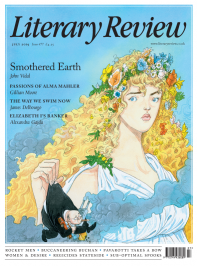Maren Meinhardt
From Tahiti to the Terror
Georg Forster: Voyager, Naturalist, Revolutionary
By Jürgen Goldstein (Translated by Anne Janusch)
University of Chicago Press 264pp £34
When Captain Cook set off in 1772 on his second voyage round the world, he was accompanied by the Prussian botanist Johann Reinhold Forster, who brought his seventeen-year-old son, Georg, with him as his assistant. Georg Forster’s role in Cook’s explorations transformed his life. Less than twenty years after that great journey, Forster died in Paris, impoverished and alone, having become caught up in the French Revolution. ‘So poor Forster did end up paying with his life for his errors,’ Goethe commented when he heard. But, according to Jürgen Goldstein in Georg Forster: Voyager, Naturalist, Revolutionary, Forster had not been led astray. In fact, Goldstein argues, his experiences on Cook’s voyage influenced his political thought and set him on the road to revolution.
Forster’s youth and relative lack of education meant that when Cook’s ship, HMS Resolution, set sail from Plymouth on 13 July 1772, he might have served as a near-perfect illustration of the Enlightenment idea of the human mind as a blank slate, something that Goldstein makes much of. There are signs, though, that Forster wasn’t always pleased to find himself in the role of experimental subject: ‘I was yoked too soon,’ he reflected later, and ‘forced to work when I still should have been learning’.
Georg Forster is not really a biography of Forster at all. The chronological facts are detailed, curtly and almost apologetically, at the beginning of each chapter, leaving Goldstein space to explore the development of Forster’s mind. Forster’s political ideas, he is keen to show, were formed not from

Sign Up to our newsletter
Receive free articles, highlights from the archive, news, details of prizes, and much more.@Lit_Review
Follow Literary Review on Twitter
Twitter Feed
It wasn’t until 1825 that Pepys’s diary became available for the first time. How it was eventually decrypted and published is a story of subterfuge and duplicity.
Kate Loveman tells the tale.
Kate Loveman - Publishing Pepys
Kate Loveman: Publishing Pepys
literaryreview.co.uk
Arthur Christopher Benson was a pillar of the Edwardian establishment. He was supremely well connected. As his newly published diaries reveal, he was also riotously indiscreet.
Piers Brendon compares Benson’s journals to others from the 20th century.
Piers Brendon - Land of Dopes & Tories
Piers Brendon: Land of Dopes & Tories - The Benson Diaries: Selections from the Diary of Arthur Christopher Benson by Eamon Duffy & Ronald Hyam (edd)
literaryreview.co.uk
Of the siblings Gwen and Augustus John, it is Augustus who has commanded most attention from collectors and connoisseurs.
Was he really the finer artist, asks Tanya Harrod, or is it time Gwen emerged from her brother’s shadow?
Tanya Harrod - Cut from the Same Canvas
Tanya Harrod: Cut from the Same Canvas - Artists, Siblings, Visionaries: The Lives and Loves of Gwen and Augustus John by Judith Mackrell
literaryreview.co.uk